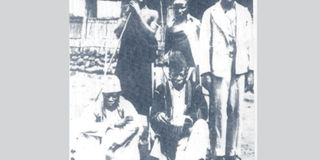Organised Wanga kingdom aided the British and Arabs

PHOTO | FILE It was during the reign of Nabongo Mumia (1888-1949) that the Wanga kingdom prospered.
Of all Kenyan communities, the Wanga were the most highly organised politically, economically, and militarily before the advent of British colonialism.
Indeed, their kingdom under the Nabongo (king) was used by the British to indirectly manage other communities.
Today, theirs still remains the only kingdom in Kenya, although it is largely a ceremonial and cultural institution.
The Wanga mainly occupy Mumias district in Kakamega County. Currently, they are under the leadership of Nabongo Peter Mumia II, who took over in 1974 and is based at Nabongo Cultural Centre in Matungu Constituency.
Nabongo Wanga, who ruled in the 11th century, is said to be the father of all Wanga people, comprising a confederation of 22 clans known as tsihanga.
But it was under the rule of Nabongo Mumia from 1888 to 1949, that the kingdom reached its peak. Mumias town came about through his influence.
Mumia ruled for 61 years at a time when Africa was getting into colonial contact with Europeans and Arabs.
The kingdom attracted many visitors from across the region, especially Arab and Swahili slave traders, resulting in a higher Islamic presence among the Wanga compared to other Luhya sub-tribes and the rest of western Kenya.
The prominence of the Wanga kingdom led to rapid territorial and political expansion in the later years of the 18th century.
The British, in their later conquest of the region, found the centrally organised political and social structures attractive and supported it in order to get allies in the imposition of colonial rule.
The Wanga lived in clans led by liguru and assisted by a council of elders. The liguru was a consultative and advisory leader to the whole community, hence the most powerful man.
However, the Nabongo, as the executive leader, was the head of the legislative and executive bodies. He was assisted by courtiers, who were experts in military matters, foreign affairs, and rainmaking.
The Nabongo was the custodian of the traditions and customs of the land. He guarded the royal regalia, which consisted of a copper bracelet and sacred spears — likutusi and lishimbishira — of the great Nabongo Wanga.
The kingdom also had members of the judiciary headed by weyengo, which constituted the court of appeal, and presided over all legal deliberations.
Apart from being advanced in ironworks, the Wanga also developed an advanced military system consisting of clan regiments, who went to war with uniforms designed from colobus monkey skin, a spear and shield and headgear identifying clan and age set.
Before the arrival of Nabongo Mumia, the Wanga kingdom was prone to succession feuds, the most notable resulting in its splitting.
For instance, the sons of Nabongo Osundwa rivalled each other over the throne.
The eldest son, Kweyu, was outwitted by a younger one called Wamukoya Netia, who then succeeded Osundwa.
In protest, Kweyu seceded and founded Wanga Mukulu (Upper Wanga). Wamukoya ruled Wanga Elureko (Lower Wanga).
One major negative aspect of the Wanga kingdom is its collaboration with Arab traders, who captured many non-Wanga people like the Bukusu in the north and the Luo from Ugenya in the south, and sold them as slaves.
Several years after the death of Mumia, his son Peter Shitawa Mumia II, was installed as Nabongo in 1974 at the age of 22. But the kingdom had lost relevance. The installation was mainly for sentimental purposes.




